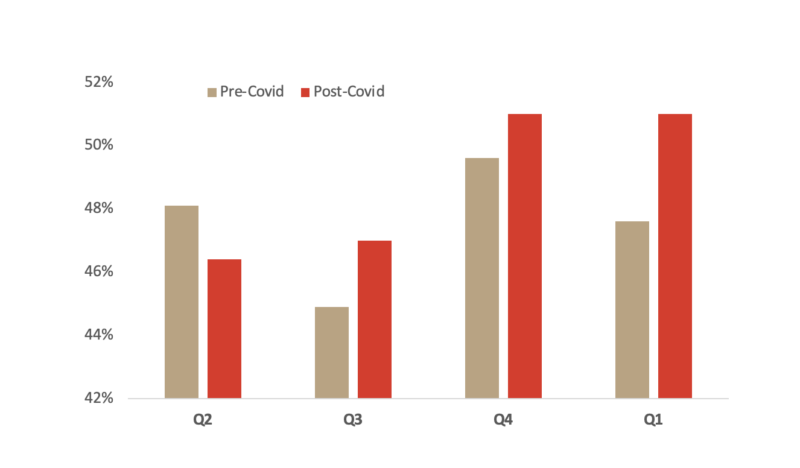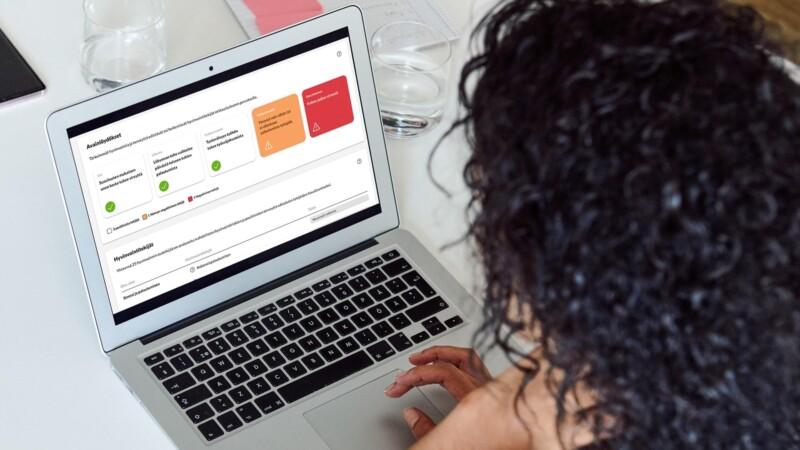
Hybrid working isn’t a new concept. The pandemic has, though, put a bigger spotlight on this flexible working model and its inevitable role in the future. And more than we may realize, our well-being has been affected by the change, both positively and negatively.
Here are some of the questions we were asked during our webinar, ‘How to improve employee well-being in the hybrid working world’, answered by Firstbeat’s Master Trainer Tiina Hoffman and Tim Wright, Vitality Head Coach Andrew Magill and Hyman Robertson’s Head of HR, Steve Moore.
You can also view the webinar in full, here.
What’s Working Right Now and What Areas Need Improvement in Hybrid Working?
According to Firstbeat data, one of the positive outcomes of the remote and hybrid working period has been that sleep duration per day increased by about 14 minutes on average, with the lack of commuting needed one likely reason for this. Also, the proportion of recovery in an average day increased during the same period.
“Until now, we have always seen a trend throughout the year,” Tiina explains. “There tends to be less recovery just before the summer holidays and right at the end of the year, and a boost at the beginning of the year. Throughout the pandemic, the proportion of recovery increased and stayed higher all year, partly because we were sleeping longer and because we weren’t going anywhere. But of course, it’s still a positive finding.”
For Steve, the increase in the level of trust and flexibility from businesses towards its people has been another positive. “I think leaders have listened more in the last 20 months – perhaps out of necessity because there hasn’t been a blueprint,” he says. “I think a much more deliberate focus on people management and well-being than we’ve seen in the past.”
On the flip side, however, self-reported stress has also seen an increase. Following a predictable trend in the previous two years (like the recovery trend mentioned before), the pandemic initially saw a decrease in self-reported stress but an increase from July 2020 onwards, remaining high thereafter. “This is obviously one of the main issues we need to address now,” Tiina says. “People aren’t feeling great because there is so much to consider, so much uncertainty. Hybrid working in principle is great, but the practicalities need to be worked out for it to work.”

Managing stress and recovery is on everyone’s agenda right now. The prolonged Covid-19 pandemic seems to have increased the perceived stress. The graph, based on Firstbeat database, represents a comparison to the results of the same period in earlier years (2017-2019).
Increased Risk of Musculoskeletal Problems
One of the most striking findings is that the number of very inactive days (under 1,000 steps) rose three-fold in all fitness categories. With workers no longer walking to the office and around the city – an easy way of accumulating at least a few thousand steps during the day – instead people weren’t leaving their house. “Most concerningly, for those people who are in general very inactive, the number of inactive days (<1000 steps) totalled between 35 to 45% of their workdays,” Tiina says. “This is obviously going to start to cause a lot of musculoskeletal problems if we cannot reverse this trend and people don’t start finding ways to fit activity into their hybrid or remote working days.”
Vitality, for their published report on hybrid working, likewise found overall levels of physical activity reduced by 28%. “Forty-five percent of remote workers are spending more time at their workstation,” Andrew says. “So, scheduling that time in for individuals to manage their musculoskeletal health, to get away from their screen is really important and we all have a responsibility to do this.”
It Should Be Easier for the Employee in a Hybrid Working Environment, Right?
Of course, the flexibility of hours brings huge advantages for employees. “We ran a number of surveys over the last 18 months around how people were feeling and the positivity around ‘no commute’ unsurprisingly came top by some way,” Steve says. “Interestingly, what came second was the ability to have a healthier lifestyle: to exercise, being able to eat more healthily at lunchtime and just have a better sense of well-being. There are definitely big advantages there.”
“On the other hand, there is the assumption that the employee makes the right decision on the balance between working from home or the office which can result in exhaustion of the social capital that we’ve built, increasing the risk of burnout and the erosion of the organization’s culture.”
“It gives more significance to the question ‘what are we going to achieve today’,” Andrew says. “Therefore, what’s the best environment and from a performance perspective, how can I best manage my stress, how do I work best and consider should I have that conversation instead in person or is it ok to do so virtually – I think that’s a huge opportunity that exists now.”
“Relationships developed in person are also different to that online,” Tim adds. “Each day blurs into the weekend which blurs into the working week. You must be much more self-disciplined. Build breaks in, find that time for exercise, mindfulness and rest breaks – otherwise it becomes quite fatiguing.”
Is Hybrid Working the New Workplace Discrimination?
“I’m not sure it is,” Steve says. “I’d find it hard from an HR perspective that it would be a cause of direct discrimination but if employers are intransigent or inflexible in their approach to how they apply these policies, then there could be a risk of indirect discrimination.”
“Employers just need to ensure they adopt the same ergonomic principles at home as the office,” Tim adds. “More prolonged sitting and a lack of fitness, as highlighted in the Firstbeat data, is not a nice place to be in terms of injuries going forward.”
Want to understand how to create an effective corporate wellness strategy to improve your employees’ well-being? Download our guide and learn.
If you liked this article, you should subscribe to our newsletter.
You might also be interested in

Optimizing Real-Time Athlete Monitoring Through Historical Data Analysis
This article is written by Domenik Theodorou, a Firstbeat Sports client and Performance Coach at RASTA Vechta, a professional basketball team competing in the Basketball Bundesliga (BBL). Prior to his…

A Journey Beyond the Numbers of Wellbeing
With the Wellness Factors reporting, Firstbeat Life service providers gain a clear overview of their clients’ well-being, which is articulated in a language that transforms coaching into everyday actions.



